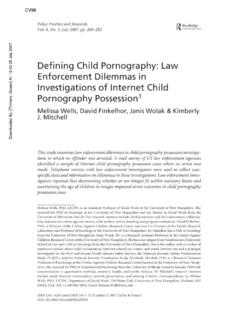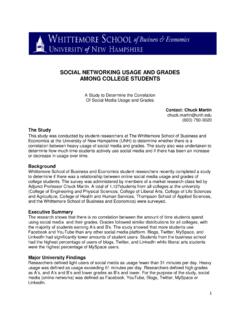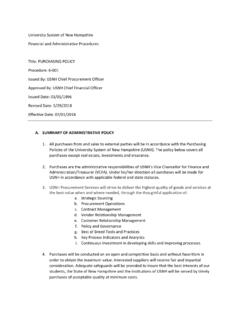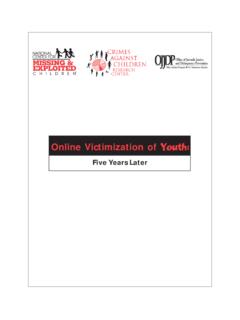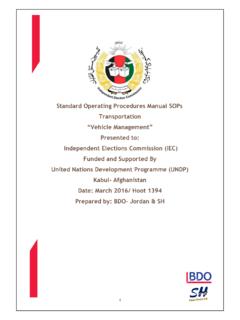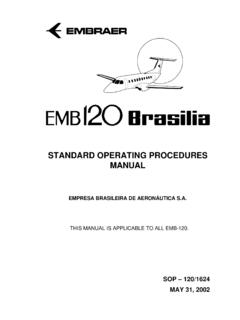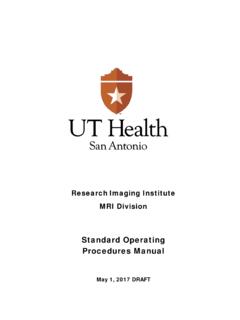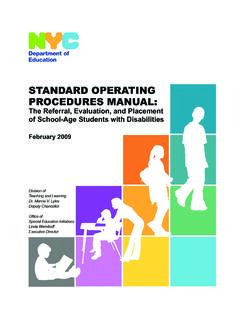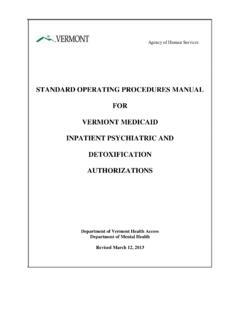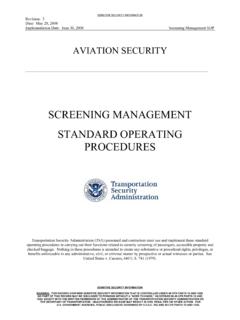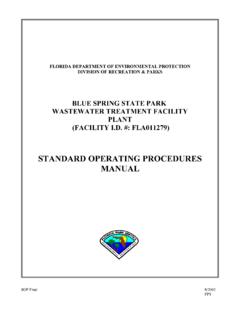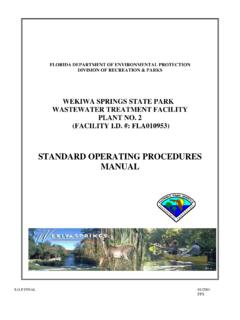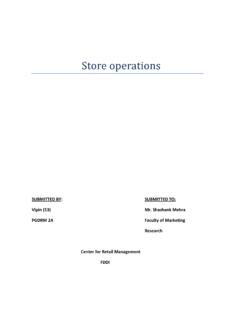Transcription of Guidelines and Standard Operating Procedures - unh.edu
1 Guidelines and Standard Operating Procedures Illicit Discharge Detection and Elimination and Pollution Prevention/Good Housekeeping for Stormwater Phase II Communities in New Hampshire NOVEMBER 2006. This report was funded by a grant from the New Hampshire Estuaries Project and the New Hampshire Department of Environmental Services, as authorized by the Environmental Protection Agency pursuant to Section 320 of the Clean Water Act. The following Seacoast Coalition members contributed to the development and review of this manual : City of Dover Town of Durham Town of Exeter Town of Greenland Town of Hampton Town of Kingston Town of North Hampton City of Portsmouth City of Rochester Town of Rye Town of Seabrook City of Somersworth University of New Hampshire New Hampshire Department of Transportation Portsmouth Naval Shipyard New Hampshire Department of Environmental Services New Hampshire Coastal Program This manual was prepared by staff from Edwards and Kelcey (Kristie Rabasca, and Christine Rinehart)
2 Using materials and feedback from the New Hampshire Department of Environmental Services, New England Interstate Water Pollution Control Commission, Center for Watershed Protection, and the Maine Guidelines and Standard Operating Procedures manual . Thanks to the City of Portsmouth (Silke Psula) and the Town of Exeter (Phyllis Duffy) for their coordination and administrative assistance. November 2006. Contents Chapter Number and Name Page: 1. 1. BASIS FOR THE OBJECTIVES OF THE CONTENT OF THE manual ..2. manual AUDIENCE AND ORGANIZATION ..3. COMMON STORMWATER POLLUTANTS, SOURCES, AND IMPACTS ..4. 2. ILLICIT DISCHARGE DETECTION AND ELIMINATION .. 7. TYPES AND SOURCES OF ILLICIT DISCHARGES ..7. LOCATING PRIORITY Identify Watersheds and Review Available Evaluate Illicit Discharge MAPPING THE SYSTEM.
3 17. Dry Weather Inspections During Mapping (or initial inspections) ..19. Long-Term Dry Weather Inspections ..19. Opportunistic Inspections ..19. Citizen Call-In Septic System TRACING ILLICIT DISCHARGES ..23. Tracing REMOVING ILLICIT CONNECTIONS AND DISCHARGES ..32. Financial Notice of Violation ..34. Emergency Discharges from Exempt TRACKING ILLICIT DISCHARGES ..37. Binder Electronic EVALUATING THE PROGRAM ..38. 3. POLLUTION PREVENTION AND GOOD HOUSEKEEPING .. 40. VEHICLE AND EQUIPMENT FACILITIES MAINTENANCE ..50. STORM DRAIN SYSTEM MAINTENANCE ..52. Conveyance System Long Term Control Structure Inspection and Maintenance ..54. i CONSTRUCTION ACTIVITIES AND OTHER LAND 4. 56. 5. GLOSSARY OF ACRONYMS .. 60. 6. INDEX .. 62.
4 Listing of Tables Page: TABLE 1-1: COMMON STORMWATER POLLUTANTS, SOURCES AND IMPACTS ..5. TABLE 2-1: LAND USES, LIKELY SOURCE LOCATIONS AND ACTIVITIES THAT CAN PRODUCE. TRANSITORY OR INTERMITTENT ILLICIT DISCHARGES ..9. TABLE 2-2: LAND USES, LIKELY SOURCE LOCATIONS AND ACTIVITIES THAT CAN PRODUCE. CONTINUOUS ILLICIT DISCHARGES ..10. TABLE 2-3: EXPLANATION OF NHDES ASSESSMENT UNIT NAMING CONVENTION ..11. TABLE 2-4: EXAMPLE PRIORITIZATION TABLE USING AVAILABLE TABLE 2-5: WORKSHEET TO PRIORITIZE AREAS ..16. TABLE 2-6: EXAMPLE WORKSHEET TO DEVELOP A DETECTION PROGRAM ..21. TABLE 2-7: WORKSHEET TO DEVELOP A DETECTION PROGRAM ..22. TABLE 2-8: INDICATOR PARAMETERS USED TO DETECT ILLICIT DISCHARGES ..28. TABLE 2-9: NOTIFICATION AND REMOVAL Procedures FOR ILLICIT DISCHARGES INTO THE.
5 MUNICIPAL SEPARATE STORM SEWER SYSTEM ..33. TABLE 2-10: EXAMPLE EXEMPT FACILITIES ..35. TABLE 2-11: SIC CODES FOR MSGP INDUSTRIAL ACTIVITIES ..36. TABLE 2-12: STORMWATER PHASE II TRACKING SHEET ..38. TABLE 2-13: IDDE PROGRAM EVALUATION TABLE 3-1: GOOD HOUSEKEEPING/POLLUTION PREVENTION SOPS/ACTIVITY MATRIX ..41. TABLE 3-2: EXAMPLE INSPECTION CHECKLIST ..48. TABLE 3-3: INSPECTION CHECKLIST ..49. TABLE 3-4: SOIL standards CATCH BASIN CLEANINGS REUSE GUIDANCE ..51. TABLE 3-5: RECOMMENDED MAINTENANCE ON COMMON LONG-TERM STORMWATER BMPS ..54. TABLE 3-6: EXAMPLE INSPECTION AND MAINTENANCE TRACKING SHEET ..55. Listing of Figures Page: Figure 2-1 Flow Chart to Select Tracing Techniques ..25. Figure 3 1 Floor Drains Available Figure 3-2 Parts Cleaning - Available Figure 3-3 Petroleum Storage - Available Options.
6 44. Figure 3-4 Petroleum Disposal - Available Figure 3-5 Vehicle Storage - Available Figure 3-6 Vehicle Washing - Available Options ..46. Figure 3-7 Vehicle Fueling - Available ii Listing of Appendices A ILLICIT DISCHARGE DETECTION AND ELIMINATION SOPS AND FORMS. IDDE: Inspections During Mapping Dry Weather Outfall Inspection Form Storm Drain Outfall Characteristics Form IDDE: Long-Term Inspections IDDE: Opportunistic Inspections IDDE: Citizen Call-In Inspections Illicit Discharge Hotline Incident Tracking Sheet IDDE: Septic System Inspections IDDE: Tracing Illicit Discharges IDDE: Removing Illicit Discharges Sample Notice of Violation B POLLUTION PREVENTION AND GOOD HOUSEKEEPING SOPS AND FORMS. Catch Basin Cleaning Catch Basin Cleaning Form Reuse Guidance Table Storm Drain System Repair and Maintenance Sample Televising Forms Erosion and Sediment Control Landscape Design and Management Storage and Disposal of Fertilizer and Pesticides Fertilizing and Turf Health Application Weed and Pest Control Application Mowing and Irrigation Vehicle and Equipment Storage Vehicle and Equipment Washing Vehicle and Equipment Fueling Spill Cleanup Parts Cleaning Spare Parts Storage Alternative Products Use/Storage/Disposal Petroleum and Chemical Disposal Petroleum and Chemical Handling Petroleum and Chemical Storage Bulk Petroleum and Chemical Storage Small Quantity Garbage Storage General Facility Housekeeping iii Floor
7 Drains Painting Street Sweeping Snow Disposal Deicing Material Storage Deicing Material Application iv Chapter 1. 1. INTRODUCTION. T. his section describes the regulatory basis, intended audience, and overall organization of this manual . BASIS FOR THE manual . KEY AREAS In April 2003, the United States Environmental Protection Agency (USEPA) issued a ADDRESSED BY National Pollutant Discharge Elimination System (NPDES) General Permit for THIS manual Stormwater Discharges from Small Municipal Separate Storm Sewer Systems (MS4s). 6 Illicit Discharge A total of 45 New Hampshire communities (six fully regulated and 39 partially Detection and regulated) became subject to Stormwater Phase II regulations based on their Elimination designation as Urbanized Areas according to the 2000 US Census.
8 See Figure 1-1 for 6 Pollution a map of the regulated communities. Prevention and Good Housekeeping for The regulation specifies issuance of a General Permit every five years. The General Municipal Permit that is valid from May 2003 through April 2008 requires that each regulated Operations community develop a five-year plan to: (R)educe the discharge of pollutants from the MS4 to the maximum extent practicable; protect water quality, and satisfy the water quality requirements of the Clean Water Act and state water quality standards .. Fourteen of the regulated communities in New Hampshire as well as three entities formed an informal coalition, the Seacoast Coalition, to collaborate on select requirements of the General Permit.
9 The Seacoast communities of New Hampshire do not have standardized Procedures for carrying out municipal operations that pertain to the management of stormwater. This manual is the creation of such a standardization providing a commonly accepted set of technical standards and guidance on stormwater management measures controlling the quantity and quality of stormwater produced from municipal activities. This manual can help jump start the communities' Illicit Discharge Detection and Elimination (IDDE) programs and provide a basis for future 1. training of employees. The Maine MS4s created a similar manual which was used as the basis for this manual (Edwards and Kelcey, 2005). This manual not only assists the municipalities in meeting the Stormwater Phase II.
10 Regulations, but encourages them to use targeted best management practices (BMPs). within the watershed with the long-term goal of consistent application by all regulated entities within the watershed. The manual of Guidelines and Standard Operating Procedures will help promote behavior that will improve the water quality of New Hampshire's lakes, ponds, streams, rivers, and estuaries. OBJECTIVES OF THE manual . The specific objectives of the manual are to: 6 Provide a commonly-accepted set of technical standards and guidance on stormwater management measures that will control the quantity and quality of stormwater produced by municipal activities, new development and redevelopment;. 6 Assist municipalities in meeting Stormwater Phase II requirements.
